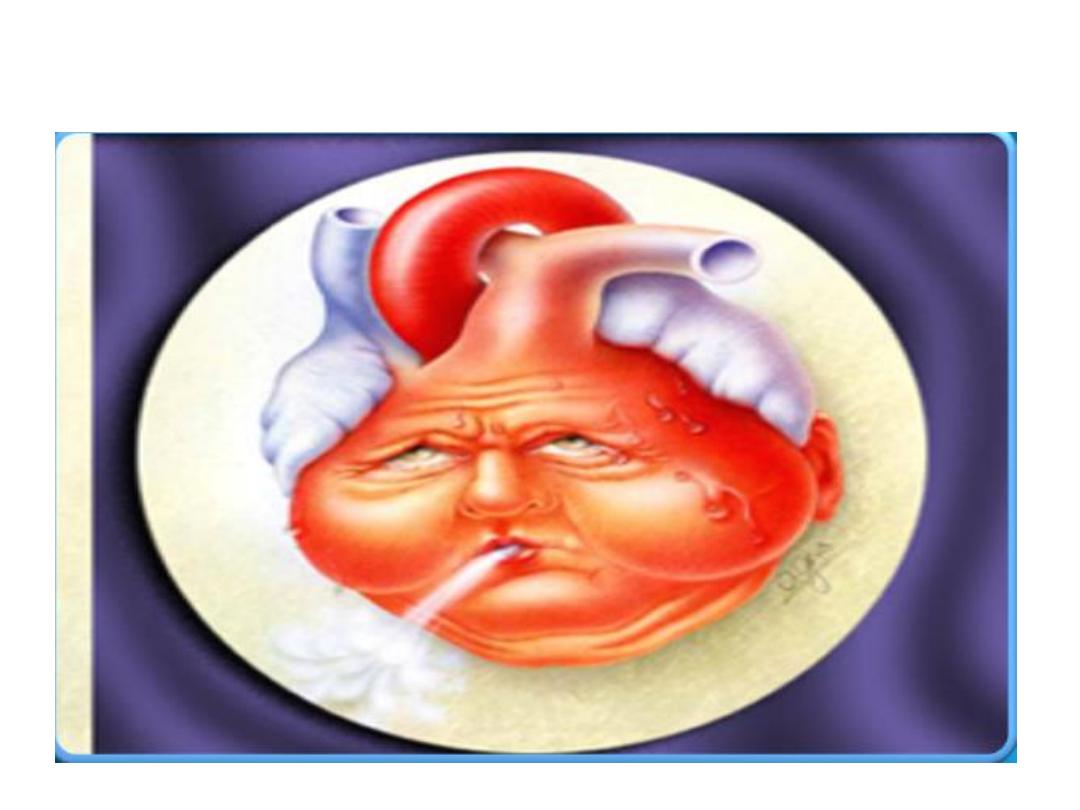

Congestive heart failure in pediatrics age groups
Congestive cardiac failure (CCF) is defined as the inability of
the heart to maintain an output required to sustain the
metabolic needs of the body at rest or during stress (systolic
failure) and inability of the heart to receive blood into
ventricular cavities at low pressure during diastole (diastolic
failure).
Heart failure may be associated with a wide spectrum of LV
functional abnormalities, ranging from patients with normal
LV size and preserved ejection fraction to those with severe
dilatation and/or a markedly reduced ejection fraction.
1- Systolic dysfunction.
2- Diastolic dysfunction.
3- Pulmonary over circulation with systemic under perfusion.

Classification:
NYHA
Class I Asymptomatic
No limitation to ordinary physical activity-no fatigue,
dyspnea or palpitation.
Class II Mild-limitation of physical activity
Unable to climb stairs.
Class III Moderate-Marked limitation
Shortness of breath on walking on flat surface.
Class IV Severe-Orthopnea-breathless even at rest
No physical activity is possible

Ross Classification:
Heart failure in infants
Mild
Intake < 3.5 ounces/feed
• Respiratory rate > 50/min.
• Abnormal respiratory pattern
• Diastolic filling sounds
• mild Hepatomegaly
Moderate
Intake < 3 ozs/feed or time taken/feed > 40mins
Respiratory rate > 60/min
Diastolic filling sounds
Moderate hepatomegaly

Severe
• Heart rate > 170/min
• Decreased perfusion - mottling of hands and feet
• Severe hepatomegaly
Note: Hepatomegaly is defied as a liver edge 3.5 cm
below the right costal margin in newborns and 2 cm
below the RCM in older children. The average liver
span is 4-5 cm in newborns and 6-8 cm in children at
12 years of age

Causes and clinical feature

• The time of onset of CHF holds the key to the
etiological diagnosis.
• Causes of HF in the fetus include supraventricular
tachycardia, severe bradycardia due to complete
heart block, severe tricuspid regurgitation due to
Ebstein's anomaly of the tricuspid valve, mitral
regurgitation from atrioventricular canal defect,
systemic arteriovenous fistula, myocarditis, etc.,
• HF presenting on the 1
st
day of life are commonly
due to metabolic abnormalities such as
hypoglycemia, hypocalcemia, asphyxia, orsepsis

• Structural diseases that produce fetal cardiac
failure can present on the 1st day.
• Conditions which present in the 1st week of life
include critical obstructive lesions such as severe
aortic stenosis, coarctation of the aorta (COA),
obstructed total anomalous pulmonary venous
connection (TAPVC), the great arteries (TGA) with
intact ventricular septum (IVS), and hypoplastic left
heart syndrome

• Development of HF due to left- to right-shunts
usually occurs with the fall in pulmonary vascular
resistance at 4–6 weeks, though large ventricular
septal defect (VSD), patent ductus arteriosus
(PDA), atrio-VSD can cause HF in the 2
nd
week of
life.
• Other conditions such as truncus arteriosus,
unobstructed TAPVC also present in the 2
nd
week of
life.

• As premature infants have a poor myocardial
reserve and their pulmonary vascular resistance
falls faster PDA may result in HF in the 1st week in
them.
• DCM is also a common cause of HF in infants.
Causes of DCM in infancy include idiopathic, inborn
errors of metabolism, and malformation
syndromes.
• Older children (usually beyond 2 years) are likely to
have other causes for HF like acute rheumatic fever
with carditis, decompensated chronic rheumatic
heart disease, myocarditis, cardiomyopathies,
rhythm disturbances

• Clinical features suggestive of HF in infants include
tachypnea, feeding difficulty, diaphoresis, etc., Feeding
difficulty ranges from prolonged feeding time (>20 min)
with decreased volume intake to frank intolerance and
vomiting after feeds. Irritability with feeding, sweating, and
even refusal of feeds are also common.
• Established HF presents with poor weight gain and in the
longer term, failure in linear growth can also result. Edema
of face and limbs is very uncommon in infants and young
children.

• The clinical features of HF in a newborn can be
fairly nonspecific and a high index of suspicion is
required. Tachycardia > 150/min, respiratory rate
>50/min, gallop rhythm, and hepatomegaly are
features of HF in infants.
• Primary cardiac arrhythmia should be considered
if heart rate is more than 220/min

• Features of HF in older children and adolescents
include fatigue, effort intolerance, dyspnea,
orthopnea, abdominal pain, dependent edema,
ascites, etc.
• Unequal upper and lower limb pulses, peripheral
bruits, or raised/asymmetric blood pressure
indicating aortic obstruction should always be
looked for in a child with unexplained HF at any age.
• COA in neonates can have normal femoral
pulsations in the presence of PDA. COA usually does
not cause HF after 1 year of age, when sufficient
collaterals have developed.

• Central cyanosis, even if mild, associated with HF
and soft or no murmurs in a newborn suggests
TGA with intact IVS, obstructed TAPVC
• Older children with tetralogy of Fallot physiology
can develop HF due to complications such as
anemia, infective endocarditis, aortic
regurgitation, or overshunting from
aortopulmonary shunts.

Investigation
CXR:
• Cardiomegaly on pediatric CXR is suggested by a cardiothoracic ratio
of >60% in neonates and >55% in older children.
• Cardiomegaly on CXR indicates poor prognosis in children with DCM
• A large thymus can mimic cardiomegaly in CXR of infants and
neonates.
• Left to right shunts usually present with cardiomegaly, enlarged main
and branch pulmonary arteries, and pulmonary plethora.
• CXR is useful in certain cyanotic CHD that presents with typical
radiographic features such as egg-on-side appearance in
transposition of great arteries, snowstorm appearance in obstructed
TAPVC, and figure of eight appearances in unobstructed TAPVC.

Electrocardiography
• Most common ECG findings in pediatric HF patients
are sinus tachycardia, LV hypertrophy, ST-T changes
• Myocardial infarction pattern with inferolateral Q
waves indicates anomalous left coronary artery
from the pulmonary artery.
• ECG is particularly useful in the diagnosis of
tachycardiomyopathy and other arrhythmic causes
of HF like an atrioventricular block

Biomarkers
• The natriuretic peptides (brain natriuretic peptide
[BNP] ,Elevated natriuretic peptide levels might be
associated with worse outcome in HF
• Blood glucose and serum electrolytes like calcium,
phosphorous should be measured in all children
with HF as their abnormalities can cause reversible
ventricular dysfunction.
• Screening for hypoxia and sepsis should be done in
newborn with HF.

• Antistreptolysin O and C-reactive protein
measurement should be done in cases of HF with
suspected acute rheumatic fever or reactivation of
chronic rheumatic heart disease.
• Metabolic and genetic testing may be considered in
primary cardiomyopathy as recent reports suggest a
genetic cause for more than 50% of patients with
DCM

Other investigation
Echocardioagraphy
Endomyocardial biopsy

Managment
• The general aims of management are to achieve
increase in cardiac performance, augment
peripheral perfusion and decrease pulmonary and
systematic venous congestion. The initial therapy is
aimed at stabilizing the infant’s condition for
diagnostic purposes

Medical Therapy
• 1. Non-pharmacological and pharmacological.
Non-Pharmacological-General Therapy
• 1. Counselling—Making parents and patients
understand the disease and principles of treatment.
• 2. Fluid—Fluid intake to be restricted in severe cases of
CCF.
• 3. Salt—High salt content to be avoided, e.g. pickle,
chips, papad, etc.
• 4. All immunizations should be given.
• 5. Regular exercises—Physiotherapy should be
encouraged.
• 6. Nutrition—Diet
• preferring small and frequent meals that are better
tolerated.

• Calorie and Protein Requirement
Caloric requirement is greater than a normal child—
120-160 Kcal/Kg/day. Caloric density has to be
increased to 24-36 Kcal/ounce. This can be achieved
by adding corn oil and sugar to the milk or formula
in phases. If the patient is not able to accept feeds,
then nasogastric feeding may have to be resorted to
The children should be advised to avoid the use of
extra salt and high sodium containing foods.

Managment
Diuretics
• Diuretics are the first line agents to reduce systemic
and pulmonary congestion
• Frusemide is given intravenously at a dose of 1–2
mg/kg or 1–2 mg/h infusion.
• For chronic use 1–4 mg/kg of frusemide or 20–40
mg/kg of chlorothiazide in divided doses are used.

• Patients who are unresponsive to loop diuretic
agents alone might benefit from the addition of a
thiazide agent like metolazone
• Diuretic-induced hypokalemia and hypontremia are
rare in children.
• Secondary hyperaldosteronism does occur in
children with HF and addition of spironolactone 1
mg/kg single dose to other diuretics conserves
potassium

Digoxin
• In the setting of chronic HF, digoxin use decreased
the rate of hospitalization and improved the quality
of life but not survival in adults.
• Digoxin is widely used in pediatric cardiac failure
• Digoxin has a very narrow safety window and it
should be avoided in premature babies, those with
renal failure and those with acute myocarditis.

• Electrolyte imbalance like hypokalemia and
hypomagnesemia should be promptly corrected to
avoid potentiation of toxicity and development of
arrhythmias.
• Digoxin has half-life of 36 hours and the initial effect
is after 30 minutes. Though rapid digitalization is
considered safe in children, slow digitalization may
be considered in a less sick child whereby 7 to 10
days would be required to achieve the desired
levels by daily maintenance dosing

• Anorexia, nausea and vomiting are amongst the
earliest signs of digitalis intoxication.
• The most frequent arrhythmia caused by digitalis is
premature ventricular beats.
• First-degree heart block in the form of prolongation
of P-R interval necessitates withdrawal of the drug.
Any new arrhythmias developing on the drug
should be considered to be digoxin related, until
proved otherwise.
• withdrawal of the drug and treatment with oral
potassium, phenytoin and lidocaine are indicated.

ACEIs
• In children with cardiac failure, the ACEIs which
have been most studied are captopril and
enalapril.Clinical improvement is demonstrated
with these agents in left to right shunts with HF as
well.
• They should be started at low doses and should be
up-titrated to a maximum tolerated, safe dose.

• ACEIs should be avoided in HF caused by pressure
overload lesions as they might interfere with
compensatory hypertrophy. Captopril is preferred in
neonates (Enalapril is the first choice for those older
than 2 years of age (0.1–0.5 mg/kg/day in two divided
doses).
• Children treated with ACEIs should be watched for
deterioration in renal function and hypotension. Other
adverse effects include cough and angioedema.
Angiotensin receptor blockers are generally reserved
for those children with systemic ventricular systolic
dysfunction who would benefit from renin-angiotensin-
aldosterone system blockade but are intolerant of
ACEIs.

• In children with HF and related conditions, carvedilol has
been the most widely studied beta-blocker. Carvedilol is
started at 0.05 mg/kg/dose (twice daily) and increased to
0.4–0.5 mg/kg/dose (twice daily) by doubling the dose
every 2 weeks. In many small scale and retrospective
studies, carvedilol was found to be effective in improving
clinical and echocardiographic parameters and preventing
transplantation
• Metoprolol (0.1–0.2 mg/kg/dose twice daily and increased
to 1 mg/kg/dose twice daily) or bisoprolol may be used as
an alternative to carvedilol. Beta-blockers should not be
administered in acute decompensated HF. Therapy should
be started at a small dose and slowly up-titrated

• Catecholaminergic drugs commonly used are dopamine 5–
20 mcg/kg/min and dobutamine 5–20 mcg/kg/min.
• Epinephrine and norepinephrine are more commonly
associated with arrhythmias and increased myocardial
oxygen demand.
• Milrinone, a phosphodiesterase inhibitor is an inotrope and
vasodilator that has been shown to prevent low cardiac
output syndrome after cardiac surgery in infants and
children.The loading dose of milrinone is 25–50
mcg/kg/min and maintenance dose is 0.25–1 mcg/kg/min.
Milrinone might cause peripheral vasodilation and should
be used with caution in hypotensive patients.
• Levosimendan is another inotrope with vasodilatory
property by a calcium-sensitizing effect and opening up of
vascular ATP-dependent K
+
channels

Device Therapy
Intra-aortic balloon pump
Cardiac resynchronization-Biventricular Pacing
Implantable cardiac defibrillator

Cardiac transplantation
• Heart transplantation remains the therapy of choice
for end-stage HF in children refractory to surgical
and medical therapy.
• The most common indication is the end-stage heart
disease due to cardiomyopathies.
• Other causes include CHDs such as hypoplastic
heart syndrome and other complex CHD, single
ventricle, and palliated heart disease.
